2016 Hyundai H350 warning
[x] Cancel search: warningPage 59 of 473

2-39
Safety system of your vehicle
2
Air bags may not inflate, when thevehicle collides with objects such
as utility poles or trees, where the
impacts are concentrated to one
point. This is because the full force
of the impact is not delivered to the
sensors.
SRS Care
The SRS is virtually maintenance-
free. Thus, you do not need to main-
tain any SRS parts by yourself. When
the SRS air bag warning light does
not Illuminate, or when it continuous-
ly remains ON, we recommend that
the system be inspected by an
authorized HYUNDAI dealer.
OEU034021
Modification to SRS compo-
nents or wirings, such as
adding badges or the pad cov-
ers or body-structure modifi-
cations, may adversely affect
SRS performance and lead to
possible injury.
Use only a soft, dry cloth or the one moistened with plain
water to clean the air pad
cover. Solvents or cleaners
may adversely affect the air
bag covers and proper
deployment.
No objects should be placed
over or near the air bag mod-ules on the steering wheel,
the instrument cluster, and
the front panel above the
glove box. Any such object
may cause harm, when the
vehicle is in a crash severe
enough to inflate the air bags.
(Continued)
WARNING
Page 61 of 473
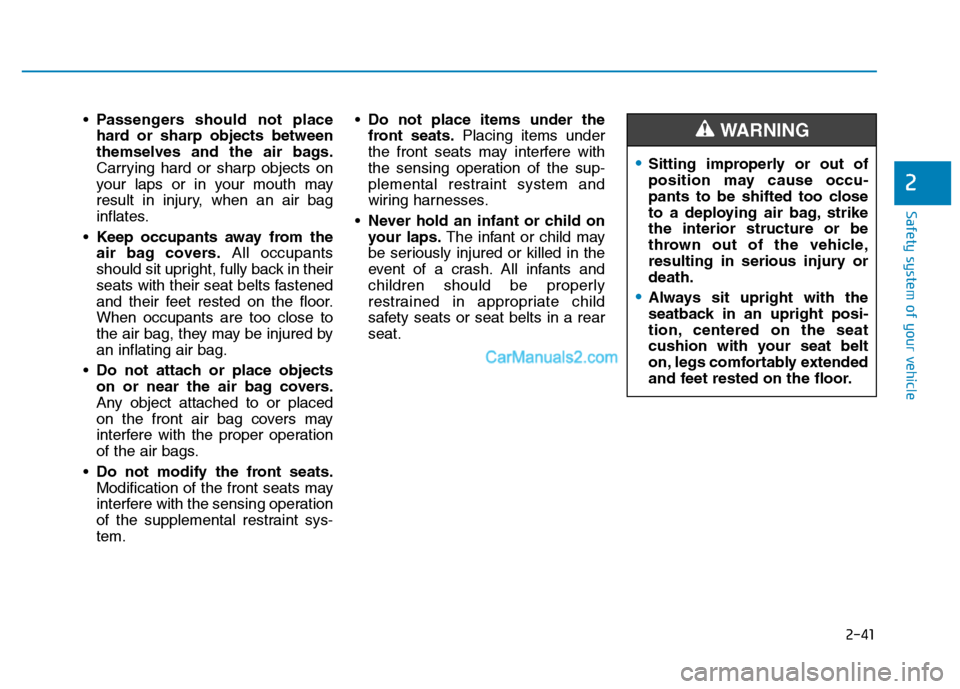
2-41
Safety system of your vehicle
2
Passengers should not place
hard or sharp objects between
themselves and the air bags.
Carrying hard or sharp objects on
your laps or in your mouth may
result in injury, when an air bag
inflates.
Keep occupants away from the
air bag covers. All occupants
should sit upright, fully back in their
seats with their seat belts fastened
and their feet rested on the floor.When occupants are too close to
the air bag, they may be injured byan inflating air bag.
Do not attach or place objects
on or near the air bag covers.
Any object attached to or placed
on the front air bag covers may
interfere with the proper operation
of the air bags.
Do not modify the front seats.
Modification of the front seats may
interfere with the sensing operation
of the supplemental restraint sys-tem.
Do not place items under the
front seats. Placing items under
the front seats may interfere with
the sensing operation of the sup-
plemental restraint system and
wiring harnesses.
Never hold an infant or child on
your laps. The infant or child may
be seriously injured or killed in the
event of a crash. All infants and
children should be properly
restrained in appropriate child
safety seats or seat belts in a rearseat.
Sitting improperly or out of
position may cause occu-
pants to be shifted too close
to a deploying air bag, strikethe interior structure or be
thrown out of the vehicle,
resulting in serious injury ordeath.
Always sit upright with the
seatback in an upright posi-
tion, centered on the seat
cushion with your seat belt
on, legs comfortably extended
and feet rested on the floor.
WARNING
Page 62 of 473
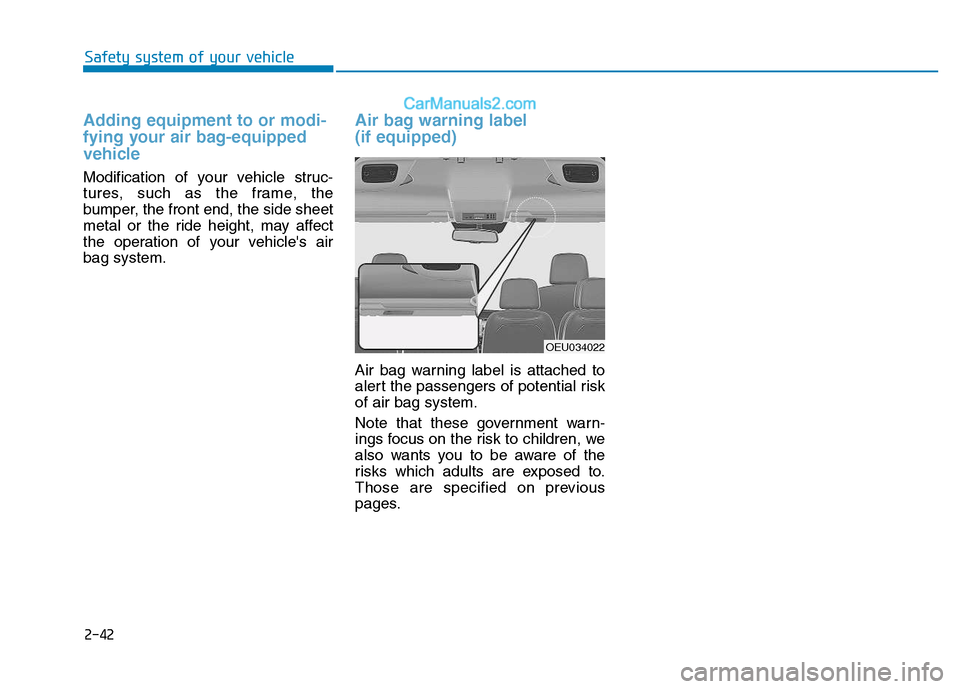
Adding equipment to or modi-
fying your air bag-equipped
vehicle
Modification of your vehicle struc-
tures, such as the frame, the
bumper, the front end, the side sheet
metal or the ride height, may affect
the operation of your vehicle's airbag system.
Air bag warning label (if equipped)
Air bag warning label is attached to
alert the passengers of potential riskof air bag system.
Note that these government warn-
ings focus on the risk to children, we
also wants you to be aware of the
risks which adults are exposed to.
Those are specified on previous
pages.
OEU034022
Safety system of your vehicle
2-42
Page 63 of 473
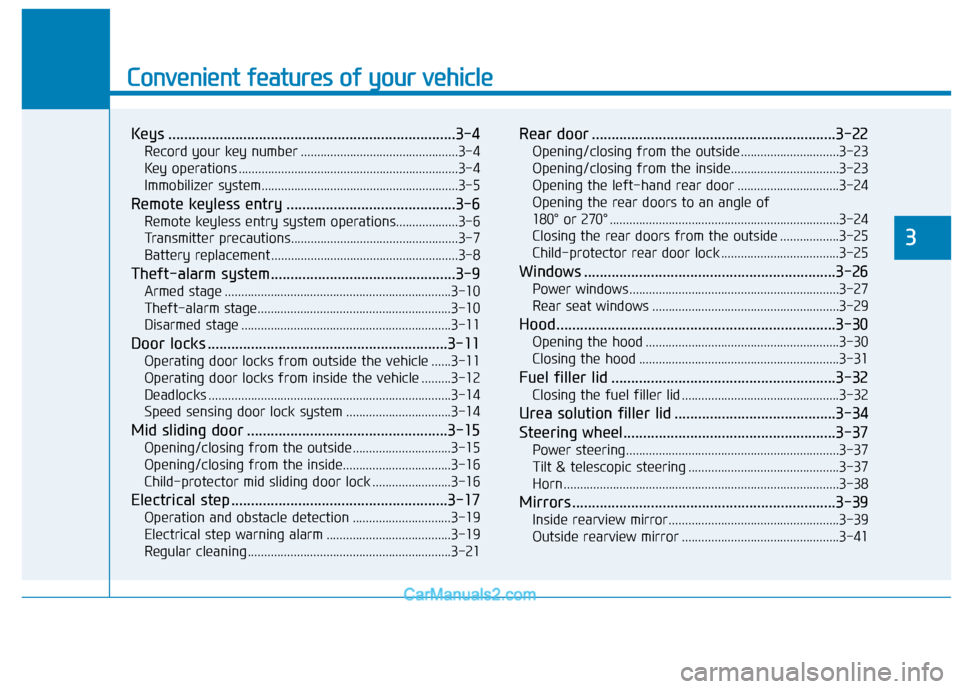
Convenient features of your vehicle
Keys .........................................................................3-4Record your key number ................................................3-4
Key operations ...................................................................3-4
Immobilizer system............................................................3-5
Remote keyless entry ...........................................3-6 Remote keyless entry system operations...................3-6
Transmitter precautions...................................................3-7
Battery replacement .........................................................3-8
Theft-alarm system...............................................3-9 Armed stage .....................................................................3-10
Theft-alarm stage...........................................................3-10
Disarmed stage ................................................................3-11
Door locks .............................................................3-11 Operating door locks from outside the vehicle ......3-11
Operating door locks from inside the vehicle .........3-12
Deadlocks ..........................................................................3-14
Speed sensing door lock system ................................3-14
Mid sliding door ...................................................3-15 Opening/closing from the outside..............................3-15
Opening/closing from the inside.................................3-16
Child-protector mid sliding door lock ........................3-16
Electrical step .......................................................3-17 Operation and obstacle detection ..............................3-19
Electrical step warning alarm ......................................3-19
Regular cleaning ..............................................................3-21 Rear door ..............................................................3-22
Opening/closing from the outside..............................3-23
Opening/closing from the inside.................................3-23
Opening the left-hand rear door ...............................3-24
Opening the rear doors to an angle of
180° or 270° ......................................................................3-24 Closing the rear doors from the outside ..................3-25
Child-protector rear door lock ....................................3-25
Windows ................................................................3-26 Power windows ................................................................3-27
Rear seat windows .........................................................3-29
Hood.......................................................................3-30 Opening the hood ...........................................................3-30
Closing the hood .............................................................3-31
Fuel filler lid .........................................................3-32 Closing the fuel filler lid ................................................3-32
Urea solution filler lid .........................................3-34
Steering wheel......................................................3-37 Power steering.................................................................3-37
Tilt & telescopic steering ..............................................3-37
Horn ....................................................................................3-38
Mirrors ...................................................................3-39 Inside rearview mirror....................................................3-39
Outside rearview mirror ................................................3-41
3
Page 64 of 473
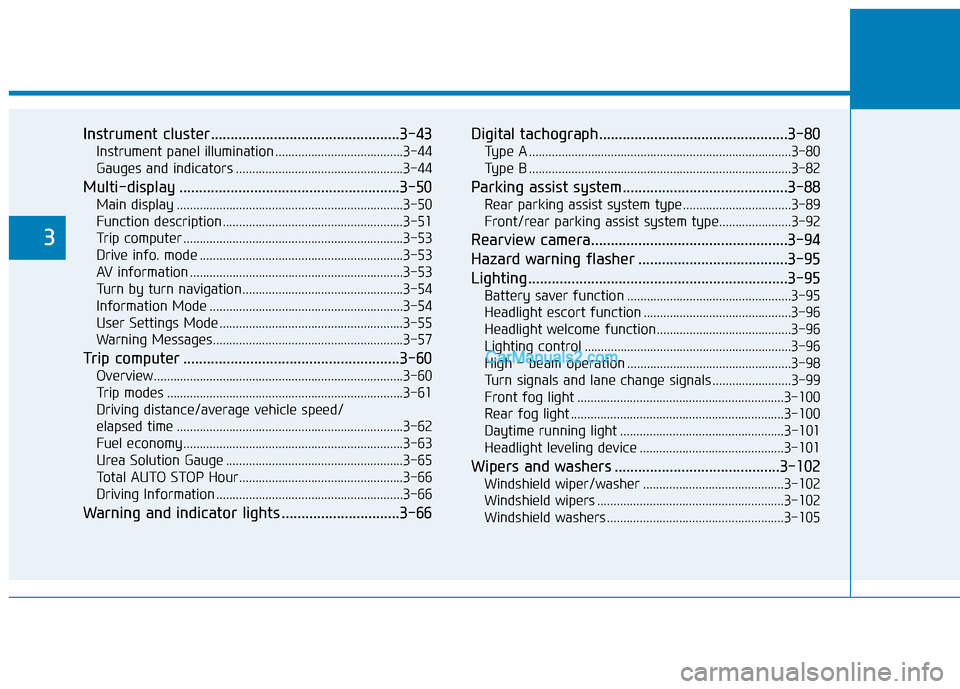
Instrument cluster................................................3-43Instrument panel illumination .......................................3-44
Gauges and indicators ...................................................3-44
Multi-display ........................................................3-50 Main display .....................................................................3-50
Function description .......................................................3-51
Trip computer ...................................................................3-53
Drive info. mode ..............................................................3-53
AV information .................................................................3-53
Turn by turn navigation.................................................3-54
Information Mode ...........................................................3-54
User Settings Mode ........................................................3-55
Warning Messages..........................................................3-57
Trip computer .......................................................3-60 Overview............................................................................3-60
Trip modes ........................................................................3-61
Driving distance/average vehicle speed/
elapsed time .....................................................................3-62 Fuel economy ...................................................................3-63
Urea Solution Gauge ......................................................3-65
Total AUTO STOP Hour..................................................3-66
Driving Information .........................................................3-66
Warning and indicator lights ..............................3-66 Digital tachograph................................................3-80
Type A ................................................................................3-80
Type B ................................................................................3-82
Parking assist system..........................................3-88 Rear parking assist system type .................................3-89
Front/rear parking assist system type......................3-92
Rearview camera..................................................3-94
Hazard warning flasher ......................................3-95
Lighting..................................................................3-95 Battery saver function ..................................................3-95
Headlight escort function .............................................3-96
Headlight welcome function.........................................3-96
Lighting control ...............................................................3-96
High - beam operation ..................................................3-98
Turn signals and lane change signals ........................3-99
Front fog light ...............................................................3-100
Rear fog light .................................................................3-100
Daytime running light ..................................................3-101
Headlight leveling device ............................................3-101
Wipers and washers ..........................................3-102 Windshield wiper/washer ...........................................3-102
Windshield wipers .........................................................3-102
Windshield washers ......................................................3-105
3
Page 66 of 473
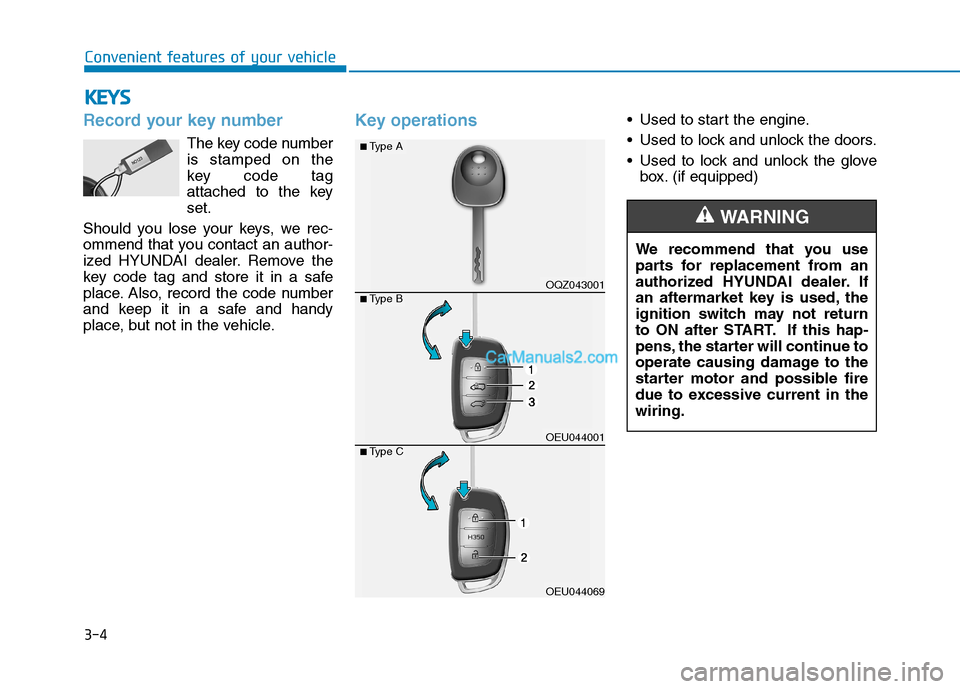
3-4
Convenient features of your vehicle
Record your key number
The key code number is stamped on the
key code tag
attached to the keyset.
Should you lose your keys, we rec-
ommend that you contact an author-
ized HYUNDAI dealer. Remove the
key code tag and store it in a safe
place. Also, record the code number
and keep it in a safe and handy
place, but not in the vehicle.
Key operations• Used to start the engine.
Used to lock and unlock the doors.
Used to lock and unlock the glove box. (if equipped)
KKEEYY SS
We recommend that you use
parts for replacement from an
authorized HYUNDAI dealer. If
an aftermarket key is used, the
ignition switch may not return
to ON after START. If this hap-
pens, the starter will continue to
operate causing damage to the
starter motor and possible fire
due to excessive current in thewiring.
WARNING
OQZ043001
OEU044001
OEU044069
■Type A
■Type B
■Type C
Page 67 of 473
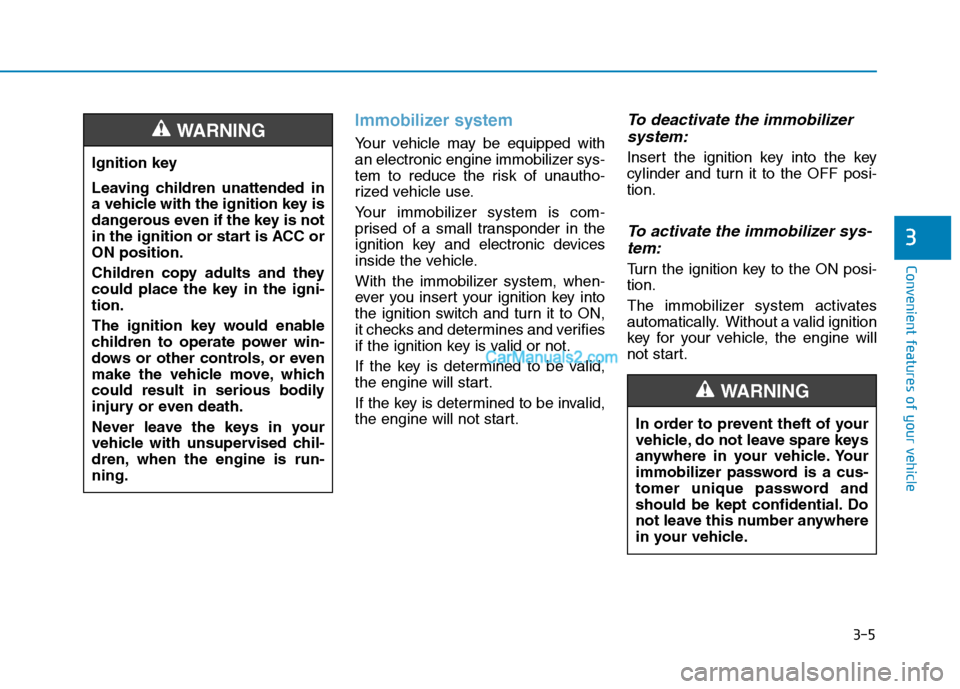
3-5
Convenient features of your vehicle
Immobilizer system
Your vehicle may be equipped with
an electronic engine immobilizer sys-
tem to reduce the risk of unautho-
rized vehicle use.
Your immobilizer system is com-
prised of a small transponder in the
ignition key and electronic devices
inside the vehicle.
With the immobilizer system, when-
ever you insert your ignition key into
the ignition switch and turn it to ON,
it checks and determines and verifies
if the ignition key is valid or not.
If the key is determined to be valid,
the engine will start.
If the key is determined to be invalid,
the engine will not start.
To deactivate the immobilizersystem:
Insert the ignition key into the key
cylinder and turn it to the OFF posi-tion.
To activate the immobilizer sys-tem:
Turn the ignition key to the ON posi-tion.
The immobilizer system activates
automatically. Without a valid ignition
key for your vehicle, the engine will
not start.
3
Ignition key
Leaving children unattended in
a vehicle with the ignition key is
dangerous even if the key is not
in the ignition or start is ACC orON position.
Children copy adults and they
could place the key in the igni-tion.
The ignition key would enable
children to operate power win-
dows or other controls, or even
make the vehicle move, which
could result in serious bodily
injury or even death.
Never leave the keys in your
vehicle with unsupervised chil-
dren, when the engine is run-ning.
WARNING
In order to prevent theft of your
vehicle, do not leave spare keys
anywhere in your vehicle. Your
immobilizer password is a cus-
tomer unique password and
should be kept confidential. Do
not leave this number anywhere
in your vehicle.
WARNING
Page 69 of 473
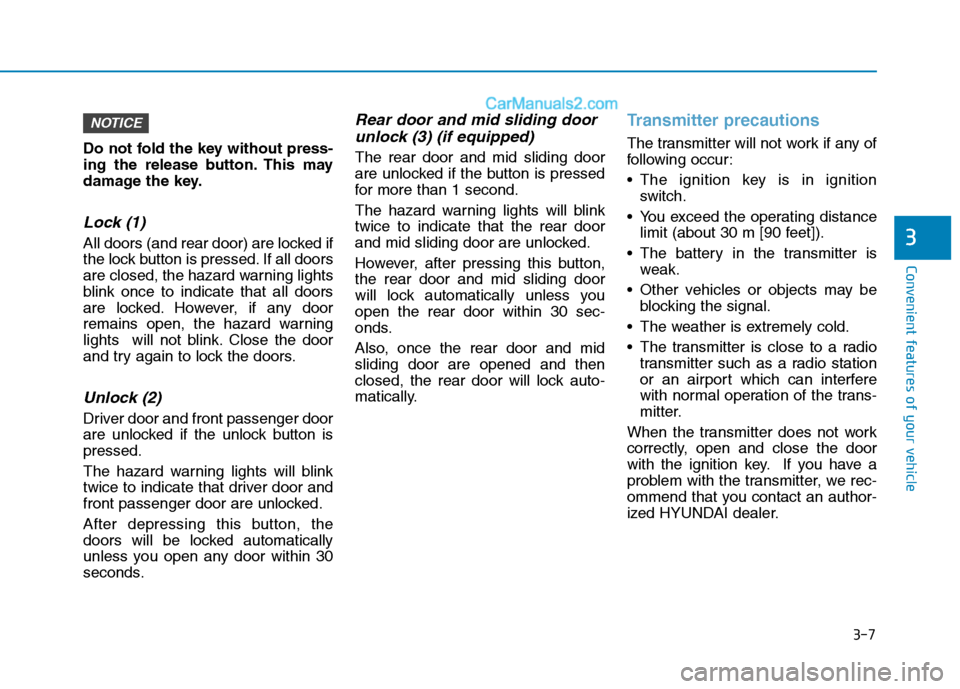
3-7
Convenient features of your vehicle
Do not fold the key without press-
ing the release button. This may
damage the key.
Lock (1)
All doors (and rear door) are locked if
the lock button is pressed. If all doors
are closed, the hazard warning lights
blink once to indicate that all doors
are locked. However, if any door
remains open, the hazard warning
lights will not blink. Close the door
and try again to lock the doors.
Unlock (2)
Driver door and front passenger door
are unlocked if the unlock button ispressed.
The hazard warning lights will blink
twice to indicate that driver door and
front passenger door are unlocked.
After depressing this button, the
doors will be locked automatically
unless you open any door within 30
seconds.
Rear door and mid sliding doorunlock (3) (if equipped)
The rear door and mid sliding door
are unlocked if the button is pressed
for more than 1 second.
The hazard warning lights will blink twice to indicate that the rear door
and mid sliding door are unlocked.
However, after pressing this button, the rear door and mid sliding door
will lock automatically unless youopen the rear door within 30 sec-
onds.
Also, once the rear door and mid sliding door are opened and then
closed, the rear door will lock auto-
matically.
Transmitter precautions
The transmitter will not work if any of
following occur:
The ignition key is in ignition switch.
You exceed the operating distance limit (about 30 m [90 feet]).
The battery in the transmitter is weak.
Other vehicles or objects may be blocking the signal.
The weather is extremely cold.
The transmitter is close to a radio transmitter such as a radio station
or an airport which can interfere
with normal operation of the trans-
mitter.
When the transmitter does not work
correctly, open and close the door
with the ignition key. If you have a
problem with the transmitter, we rec-
ommend that you contact an author-
ized HYUNDAI dealer.
NOTICE
3